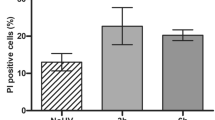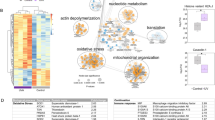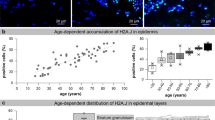Abstract
The carcinogenic effects of sunlight in human epidermis may be thwarted by either: transient growth arrest and repair of DNA photodamage in keratinocytes (KCs); elimination of KCs with damaged DNA via apoptosis; or by stimulating a senescence switch whereby KCs become irreversibly growth arrested. Using normal human skin organ cultures and living epidermal equivalents, we demonstrate that in the proliferative basal layer, removal of KCs via apoptosis had a rapid onset (beginning within 2 h) following UV-light exposure generating progressively greater numbers of KCs with thymine dimers as the dose of UV-light was increased; involved induction of Apaf-1, activation of caspase-3, and was dependent on p53 activation as addition of a p53 chemical inhibitor blocked the apoptotic response. Suprabasal layer KCs underwent apoptosis at much later time points (>8 h). KCs in the basal layer repaired DNA damage more rapidly than KCs in suprabasal layers. Steady state levels of p53 increased in irradiated cells, and the increase was accompanied by phosphorylation of serine 9 and serine 15, but not serine 6 residues. By contrast, cultured KCs undergoing spontaneous replicative senescence were resistant to UV-induced apoptosis. Senescent KCs constitutively contained low levels of p53, which were neither increased nor phosphorylated or acetylated after UV-exposure and possessed minimal DNA binding activity, indicative of functional inactivation. Furthermore, treatment of senescent KCs with DNA damaging agent adriamycin did not result in activation of latent p53 or apoptosis. When KCs within psoriatic plaques were examined, they resembled senescent KCs in that they expressed p53, which was not phosphorylated or acetylated. Thus, UV-light induces DNA damage in human epidermal KCs triggering p53 activation, and subsequent apoptosis involving distinct cell layers and kinetics. However, the lack of p53 activation as seen in senescent KCs and psoriatic plaques, is associated with a relative resistance of KCs to UV-induced apoptosis. In conclusion, the sensitivity and resistance of KCs to apoptosis depends not only on the location within various layers of epidermis and levels of p53, but may also involve p53 activation via post-translational modifications.
This is a preview of subscription content, access via your institution
Access options
Subscribe to this journal
Receive 50 print issues and online access
$259.00 per year
only $5.18 per issue
Buy this article
- Purchase on Springer Link
- Instant access to full article PDF
Prices may be subject to local taxes which are calculated during checkout









Similar content being viewed by others
References
Ananthaswamy HN, Loughlin SM, Cox P, Evans RL, Ullrich SE, Kripke ML . 1997 Nat. Med. 3: 510–514
Appella E, Anderson CW . 2001 Eur. J. Biochem. 268: 2764–2772
Atadja P, Wong H, Garkavstev I, Veillette C, Riabowol K . 1995 Proc. Natl. Acad. Sci. USA 92: 8348–8352
Berg RJW, Van Kranen HJ, Rebel HG, DeVries A, Van Vloten WA, VanKreijl CF, Vancer Leun JC, DeGruijl FR . 1996 Proc. Natl. Acad. Sci. USA 93: 274–278
Brash DE . 1996 Nature Med. 2: 525–
Brash DE, Ziegler A, Jonason AS, Simon JA, Kunala S, Leffell DJ . 1996 J. Invest. Dermatol.; Symp. Proc. 1: 136–142
Burren R, Scaletta C, Frenk E, Panizzon RG, Applegate LA . 1998 Intl. J. Cancer 76: 201–206
Campisi J . 1998 J. Invest. Dermatol.; Symp. Proc. 3: 1–5
Campisi J . 2000 In Vivo 14: 183–188
Chaturvedi V, Qin J-Z, Denning MF, Choubey D, Nickoloff BJ . 1999 J. Biol. Chem. 274: 23358–23367
Cleaver JE . 1968 Nature 218: 652–656
Cleaver JE, Mitchell DL . 1996 Cancer Medicine Holland JF, Frei EI, Bast RCJ, Kufe DW, Morton DL and Weichselbau RR. (eds) Williams and Wilkins: Baltimore pp 307–318
Dazard JE, Piette J, Basset-Seguin N, Blanchard JM, Gandarillas A . 2000 Oncogene 19: 3693–3705
Dumaz N, Meek DW . 1999 EMBO J. 18: 7002–7010
Fukuchi Y, Kizaki M, Yamato K, Kawamura C, Umezawa A, Hata J, Nishihara T, Ikeda Y . 2001 Oncogene 20: 704–713
Giaccia AJ, Kastan MB . 1998 Genes Dev. 12: 2973–2983
Gniadecki R, Hansen M, Wulf HC . 1997 J. Invest. Dermatol. 109: 163–169
Gottifredi V, Shieh S, Taya Y, Prives C . 2001 Proc. Natl. Acad. Sci. USA 98: 1036–1041
Hall PA, McKee PH, Menage HP, Dover R, Lane DP . 1993 Oncogene 8: 203–207
Helander SD, Peters MS, Pittelkow MR . 1993 J. Amer. Acad. Dermatol. 29: 741–748
Itahana K, Dimri G, Campisi J . 2001 Eur. J. Biochem. 268: 2784–2791
Jonason AS, Kunala S, Price GJ, Restifo RJ, Spinelli HM, Persing JA, Leffell DJ, Tarone RE, Brash DE . 1996 Proc. Natl. Acad. Sci. USA 93: 14025–14029
Komarov PG, Komarova EA, Kondratov RV, Christov-Tselkov K, Coon JS, Chernov MV, Gudkov AV . 1999 Science 285: 1733–1737
Kubilus J, Christopher C, Pat N, Holly S, Klausner M . 1996 In Vitro Toxicol. 9: 157–166
Kulja KS, Lehman JM . 1995 Exp. Cell Res. 217: 336–345
Kulms D, Poppelmann B, Yarosh D, Luger TA, Krutmann J, Schwarz T . 1999 Proc. Natl. Acad. Sci. USA 96: 7974–7979
Levine AJ . 1997 Cell 88: 323–331
Li G, Mitchell DL, Ho VC, Reed JC, Tron VA . 1996 Amer. J. Pathol. 148: 1113–1123
Li G, Tron VA, Ho VC . 1998 J. Invest. Dermatol. 110: 72–75
Meek DW . 1998 Cell. Sig. 10: 159–166
Moroni MC, Hickman ES, Denchi EL, Caprara G, Colli E, Cecconi F, Muller H, Helin K . 2001 Nat. Cell Biol. 3: 552–558
Morris RJ, Coulter K, Tryson K, Steinberg SR . 1997 Cancer Res. 57: 3436–3443
Nakazawa H, English D, Randell PL, Nakazawa K, Martel N, Armstrong BK, Yamasaki H . 1994 Proc. Natl. Acad. Sci. USA 91: 360–364
Nickoloff BJ . 2001 J. Cut. Pathol. 28: 57–64
Nickoloff BJ, Denning M . 2001 J. Invest. Dermatol. 117: 1–2
Pavey S, Conroy S, Russell T, Gabrielli B . 1999 Cancer Res. 59: 4185–4189
Pavey S, Russell T, Gabrielli B . 2001 Oncogene 20: 6103–6110
Ponten F, Lindman H, Bostrom A, Berne B, Bergh J . 2001 J. Natl. Cancer Inst. 93: 128–133
Qin JZ, Chaturvedi V, Denning MF, Choubey D, Diaz MO, Nickoloff BJ . 1999 J. Biol. Chem. 274: 37957–37964
Qin J-Z, Bacon P, Chaturvedi V, Nickoloff BJ . 2001 J. Invest. Dermatol. 117: 898–907
Rees JL . 1995 J. Invest. Dermatol. 107: 883–884
Robles AI, Bemmels NA, Foraker AB, Harris CC . 2001 Cancer Res. 61: 6660–6664
Sager R . 1991 Env. Health Persp. 93: 59–62
Shieh SY, Ikeda M, Taya Y, Prives C . 1997 Cell 91: 325–334
Soengas MS, Alarcon RM, Yoshida H, Giaccia AJ, Hakem R, Mak TW, Lowe SW . 1999 Science 284: 156–159
Soini V, Paaco P, Letho P, Oikarinen A, Vahakansas K . 1994 Br. J. Dermatol. 131: 514–520
Spandau DF . 1994 Oncogene 9: 1861–1868
Stege H, Roza L, Vink A, Grewe M, Ruzicka T, Grether-Beck S, Krutmann J . 2001 Proc. Natl. Acad. Sci. USA 97: 1790–1795
Terui T, Okuyama R, Tagami H . 2001 Curr. Opin. Allerg. Clin. Immunol. 1: 461–467
Tornaletti S, Rozek D, Pfeifer G . 1993 Oncogene 8: 2051–2057
Tron VA, Trotter MJ, Tang L, Krajewska M, Reed JC, Ho VC, Li G . 1998 Am. J. Path. 153: 579–585
Tyner SD, Venkatachalam S, Choi J, Jones S, Ghebranious N, Igelmann H, Lu X, Soron G, Cooper B, Brayton C, Park SH, Thompson T, Karsenty G, Bradley A, Donehower LA . 2002 Nature 415: 45–53
Unger T, Sionov RV, Moallem E, Yee CL, Howley PM, Oren M, Haupt Y . 1999 Oncogene 18: 3205–3212
Webley K, Bond JA, Jones CJ, Blaydes JP, Craig A, Hupp T, Wynford-Thomas D . 2000 Mol. Cell Biol. 20: 2803–2808
Wolf P, Cox P, Yarosh DB, Kripke ML . 1995 J. Invest. Dermatol. 104: 287–292
Wrone-Smith T, Johnson T, Nelson B, Boise LH, Thompson CB, Nunez G, Nickoloff B.J . 1995 Am. J. Path. 146: 1079–1088
Wrone-Smith T, Mitra RS, Thompson CB, Jasty R, Castle VP, Nickoloff BJ . 1997 Am. J. Path. 151: 1321–1329
Yaar M, Gilchrest BA . 1998 J. Invest. Dermatol. 3s 47–51
Yeager TR, DeVries S, Jarrard DF, Kao C, Nakada SY, Moon TD, Bruskewitz R, Stadler WM, Meisner LF, Gilchrest KW, Newton MA, Waldman FM, Reznikoff CA . 1998 Genes Dev. 12: 163–174
Ziegler A, Jonason AS, Leffell DJ, Simon JA, Sharma HW, Kimmelman J, Remington L, Jacks T, Brash DE . 1994 Nature 372: 773–776
Acknowledgements
The authors thank Stephanie Russo and Jodie Carroll for manuscript preparation. This work was supported by NIH grants AR 40065 and AR 47307 (BJ Nickoloff).
Author information
Authors and Affiliations
Corresponding author
Rights and permissions
About this article
Cite this article
Qin, JZ., Chaturvedi, V., Denning, M. et al. Regulation of apoptosis by p53 in UV-irradiated human epidermis, psoriatic plaques and senescent keratinocytes. Oncogene 21, 2991–3002 (2002). https://doi.org/10.1038/sj.onc.1205404
Received:
Revised:
Accepted:
Published:
Issue Date:
DOI: https://doi.org/10.1038/sj.onc.1205404
Keywords
This article is cited by
-
NB-UVB irradiation downregulates keratin-17 expression in keratinocytes by inhibiting the ERK1/2 and STAT3 signaling pathways
Archives of Dermatological Research (2018)
-
Unexpected dose response of HaCaT to UVB irradiation
In Vitro Cellular & Developmental Biology - Animal (2018)
-
Keratinocyte Apoptosis in Epidermal Remodeling and Clearance of Psoriasis Induced by UV Radiation
Journal of Investigative Dermatology (2011)
-
Increased expression of TRAIL and its death receptors DR4 and DR5 in plaque psoriasis
Archives of Dermatological Research (2011)
-
A New Paradigm for the Role of Aging in the Development of Skin Cancer
Journal of Investigative Dermatology (2009)



